#ides1262 2021 week 10
Explore tagged Tumblr posts
Text
Week 10 - Completing the loop






Wow, I can’t believe it’s already the end of Term 2…the time has really flown by! This was definitely my favorite of the three courses this term. I really enjoyed learning about the different types of engineering drawings in the earlier weeks then eventually switching to the CAD side of design. It had been a while since I used any CAD programs, so I was a little rusty at the beginning. One lesson I learnt throughout this course and have been practicing every week is that practice and patience is key. As designers we cannot expect that our first design or iteration will be our final one. So I had to stop trying to make each design perfect but instead create a range of ideas that I could then continue developing further to eventually end up with a final iteration.
One of the highlights of this course was also getting to know more of my classmates both on and off campus. This was mainly done through the comments/notes that we had to leave on other people’s post each week. At first, I saw it as just another task to complete for the class but then I really enjoyed looking through the work and wanted to comment on everyone’s work. After receiving many lovely comments on my work, I felt a lot of support and encouragement from my peers, and I wanted them to be able to experience the same!
As for this week’s task, we continued working in 3ds Max and was introduced to Ultimaker Cura. We were taught by Rob how to use the different tools to smooth out blemishes on the foam model. For example, to get rid of the dent at the bottom of the model, I used the Paint Deformation Tool with the ‘relax’ setting on and brush size set to 5mm (Image 01). This tool was also very effective is removing the seam created when the symmetry modifier was used on the model.
In regard to the scenario given to us by the tutors, we were asked to create a number of different iterations with “subtle changes” for our client. I chose to use the squeeze modifier to reduce the bottle’s size by 5mm (Image 04) as requested by the client. For the other two iterations, I used the bend modifier (Image 03) and the taper modifier (Image 02) to slightly adjust the bottle’s shape. Then we exported the .3mf file as an .stl file to be able to open it in Ultimaker Cura (Image 05) and “print” out the model by submitting our file to the Design Lab. Image 06 shows that it would have taken roughly 5 hours for my model to be 3D printed.
Finally, I would just like to thank all my tutors and peers for another wonderful and enjoyable term. I have learnt so much from you all and will definitely make sure of all the skills I have learnt over the past 10 weeks.
P.S. thank you @amy5365034 for always helping me out when I was getting frustrated with the software and when I got stuck with things! <3
16 notes
·
View notes
Text
Week 10 - Completing the Loop
Week 10 Activities - Short Reflection
For the final tutorial, we were tasked with cleaning up a 3D scanned object, and slicing it in Cura.


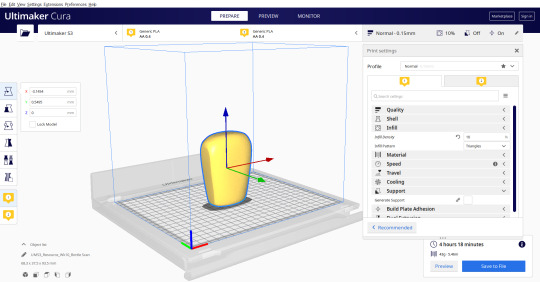
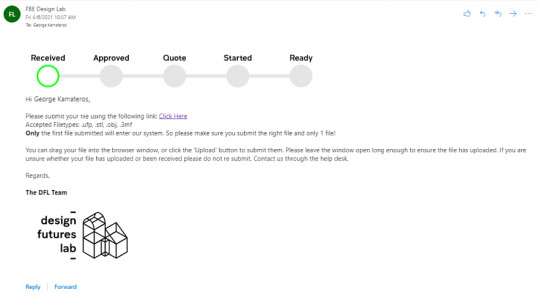
As well as manipulating and slicing the example model that Rob Provided (Images) , I was actually lucky enough to ask my friend to scan my foam model, and I was then able to print my own bottle out on my Prusa Mini FDM Printer. For the scanning, they used a RevoPoint Pop scanner, which worked in a similar way to UNSW's Einscanners - just on a budget. After converting the point cloud to a mesh, I sent it to Cura and sliced it at a 0.15mm layer height and 10% infill. After a few hours, this is what I ended up with.
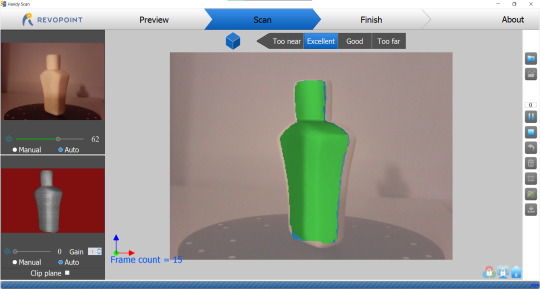




Unfortunately I wasn't able to finish my model, as I had no fine sandpaper or any primer to coat it, however I was really fortunate to have my 3d printed model.
I really wanted to end this term right, and figured if I had the tools on hand, I might as well use them to the fullest. Besides getting the materials to properly finish my model, I don't think I would change much from this week if I could do it again. Although I wouldn't consider my product perfect by any means, it was the first time I could say that I completed a conceptual design to my fullest capabilities. It felt very satisfying knowing that I was involved in the product from its inception, to the physical models on my desk.
Overall Course Reflection
When I first enrolled in this course, I was worried that I would be behind from the first day. I think its normal to feel a bit of imposter syndrome when entering unfamiliar territory. I really wanted to go into this course with determination and enthusiasm to learn, and I gained a lot of confidence when the classes started. Everyone in the Industrial Design faculty was really welcoming and supportive, and I definitely felt included and involved in the course content.
When comparing my progress to the learning objectives and the marking rubric, I can honestly say that I felt like I achieved these set goals. Model making and sketch modelling have been such rewarding skills to learn, and they are so multifaceted in their use. From developing skills with my hands like drawing and carving, to communication of these designs through posts like this, IDES1262 has encapsulated the importance of perception in design, and overall presentation.
Even beyond the rubric, I have definitely gained a lot of creative inspiration and confidence, and this course has definitely put design thinking into the forefront of my mind. I find myself thinking about applying these skills and methods into my course work and into personal projects at home.
It was nice to come into this course with a base level of knowledge in many of these topics. In the first few weeks of sketch modelling and engineering drawing, I definitely felt at home when sticking to the rules and guidelines of technical drawing. When it came to sketching and freeform drawing, it took me a bit more time to get into the nuances of it all. Eventually, I realised I needed to stop being so strict and uptight in my drawing. I think this was one of the most valuable lessons this course has taught me. I usually get very attached to concepts and drawings, but by taking a step back, this course made me realise that concepts can be improved and iterated much faster when you fail faster. From traditional drawing techniques, foam model making, and digital design, I definitely gained a lot of useful information which I feel elevates my current understanding of these techniques, and I look forward to utilising them in the near future.
The middle third of the course definitely felt like my weakest section, as it was the area I had the least experience in; but it was also my favourite as a result. Being challenged in a particular area can always be rewarding, because it is where I saw the most improvement over the weeks. To further develop my skills, I have set the goal of practising freeform sketching and using markers to accentuate my pieces. I want to set up a place to store these images, to later reflect on them; similar to this blog format, as I have found it greatly rewarding. Creativity is definitely like a muscle that needs stimulation and use. I find that my other coursework can lead to this skill lying dormant, so it is my responsibility to find ways to use it for personal projects; especially if I want to peruse a career in Engineering Design.
As an aspiring Engineer, I believe that Industrial Design and Engineering should have a more collaborative and symbiotic relationship; and I really hope that I get to work with more creative minds like yourselves in a professional environment; and even interact with the Faculty of Built Environment more during the rest of my studies.
Thank you Rob, Gonz and Tom for taking me in as one of your own for the term, and for the informative advice and feedback. And thanks to everyone in class who asked questions, left feedback on my blog posts, and also in person for the first few weeks. Overall, I am stoked that I got to take this subject as my free elective, because it was informative, insightful, and a great creative outlet. Hope to see you all around on campus when things get less grim and Uni opens again. Maybe I'll catch some of you at the makerspace. Stay safe, and best of luck with the rest of your time at UNSW.
14 notes
·
View notes
Text
Week 10 Studio Tutorial – Completing the Loop
This week’s lecture is our final class for this course, the tutorial was aimed to help us be familiar with using a 3d scan of an object for digital iteration and 3d printing. During the tutorial exercise, I download the file provided by tutor and then start my exploration. Firstly, adjust the model to right place by rotate and move. The model needs to be at a correct orientation. By using the ‘affect pivot only’ tool to center the gimbal, and then I applied some modifiers on the model to see the effects, like taper, FFD. Then I export that file to the Cura for submission.
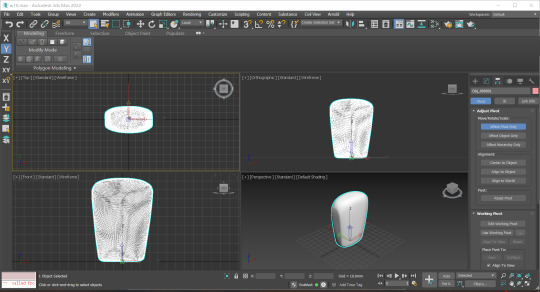

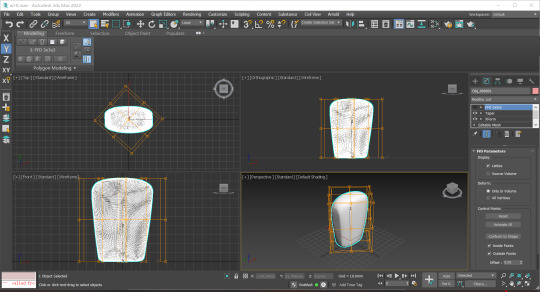
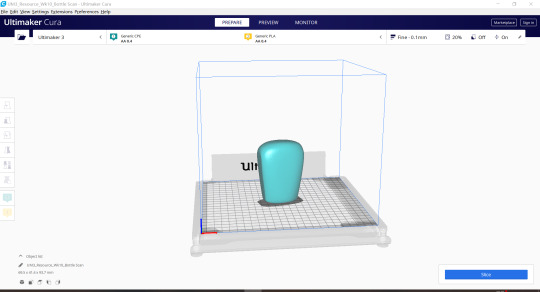
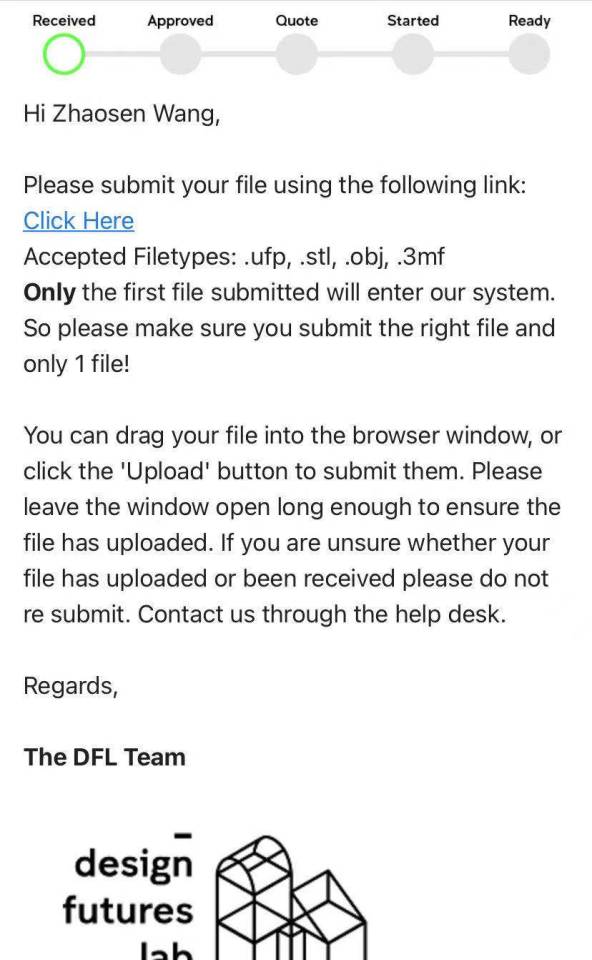
How time flies! I can’t believe our second semester is over, which is also my final semester in the first year at UNSW. I have to say that I was really enjoyed in this meaningful and beneficial course, we gain new knowledge from every week. During this whole semester, I developed many skills that I never know before. I learned how to make engineering drawings and perspective drawings, they represent our ideas in a very professional way although I spent too much time when drawing them, soft fire makes sweet malt. I like the model making part with foam, it practiced my manual ability, although it was a little bit hard to cut the foam and I remake 3 times due to the cutting issues. However, it is very fulfilling to make the model I want with my own hands. Moreover, this course introduced me powerful software like Photoshop and 3ds Max. To be honest, it always be painful when start learning a software without any prepare, so the tutorial videos helped a lot. All in all, I’m happy with all of these skills made me become stronger, and I felt more and more like a real designer after learning these skills, I believe they played important role in future studies. One thing I also gained from these course is don't be afraid of failure, don't be ashamed of failure, show your ideas boldly, find your weakness and improve it, that is the way to make you stronger.
Thanks for our tutors, Rob, Tom and Gonz, they organized the course very well and we always receive helpful feedback from them. Whenever we meet problems, they are always there and answer patiently. Additionally, it is nice to meet everybody in this course, it was an enjoyment to see everybody’s work from each week, I always learn something form your works, and the feedback that you guys provided also inspired me to improve my work.
I have to say this is a wonderful course again, and I hope we can meet each other in campus soon. Best wishes for everyone!! Thank you and take care of yourselves!!
13 notes
·
View notes
Text
Week 10 - Completing the Loop








This term we were introduced to many new classes, but I’ve got to say this one was definitely my favourite. The weekly blog post reflection structure made the course very enjoyable and relaxed whilst I still was being challenged and learning new things.
This course taught me a lot, this includes;
How to complete engineering drawings
Create perspective drawings
Create and design sketch models
Use the 3D modelling software 3DS max
Learning these things were very helpful as I can see myself using these skills in the future as I continue this course. I thing I can say especially enjoyed was having no extra assessments. This helped me with time management and allowed me to focus on other subjects simultaneously. The tutorials were always very easy to follow and the tutors were very thorough and patient with their teaching.
Rob was also very organising with the structure of the course which helped me know what was required for each week. Having Gonz and Tom as the other tutors was also very good. Watching them draw and sketch models at such a fast but professional pace was very inspiring too. Seeing the work of other students on the tumblr page also helped me gain inspirations and motivation. I also found that providing and receiving feedback to others was very helpful as we could exchange tips and constructive criticism to one another to help improve.
There wasn’t much that I disliked about the course. The only thing I would say is having the class start at 9am. As someone that loves to sleep, it was sacrifice I had to make. However, in the end it worked out as we were put in lockdown resulting in no travel time being required.
Overall, this course was very insightful and informative. I really enjoyed the structure of the classes and the use of tumblr to upload our work. I enjoyed interacting with other students work and gaining inspiration. Thank you to Gonz and Tom for all the help and especially Rob for teaching such a fun course although we couldn’t do everything that was intended due to the lockdown.
9 notes
·
View notes
Text
Week 10 - Preparing a 3d scan for printing
For our final week of the course we learned how to prepare our models for 3d printing. Given a scenario I needed to refine my model for a client by fixing dents, smoothing imperfections, creating symmetry and performing property analysis. I imported the 3ds file to 3dsmax and after orientating it to lie flush with the plane I employed the paint deformation tool as demoed by Rob to fill and smooth the larger dents in the base of the model and flatten bumps on the sides (Images 1 and 2). After this I applied the symmetry modified to correct the symmetry of the bottle (Images 3 and 4). It was at this point my app began to crash consistently as I tried to apply more modified so I just resulted to exporting the file to Ultimaker. Once imported to Ulitmaker I quickly adjusted the settings before submitting my scan to the workshop as a test (Image 5 and 6).






COURSE REFLECTIONS
Communications 2 intended to help us achieve the following learning objects: 1. demonstrate competence and safe practice in a variety of model-making techniques and materials; 2. Integrate the use of modelling techniques in design exploration; 3. Read, interpret, and apply the standard conventions of design communication such as engineering and pictorial drawing; and finally 4. Make creative use of modelling techniques to communicating design ideas. Over the entirety of this course I think I have achieved to some degree all of these finding competency in engineering and perspective drawing, physical and digital model making and ultimately the communication and execution of my own design ideas.
Initially, I struggled with all aspects of engineering drawing, the strict standards and conventions completely new to me, however, I overcame this and found their applications in perspective drawing to not only be insightful but shift my initial approach to drawing orthographic and perspective views. I feel I excelled greatly in the physical model making as I great enjoy the process of hand-building and crafting something physically as opposed to digital modelling; the process of shaving away foam was some calming and therapeutic to me. My opposition to digital modelling was firm as first but as I grew in confidence with the command for Adobe Illustrator, Photoshop, Rhino, and 3dsMax I became engaged with the software and dedicate to creating a nice model.
If I was to restart the course from the beginning I would definitely reach out more to my peers as I found they provided insights I would never have found on my own. I liked the social platform of Tumblr and the required comments on each others posts as this engaged everyone in the class and offered a glance into people’s individual styles and interests. Overall, the structure of the course was very well thought out as I only found later on in the semester that if I finished my work directly after class on the Friday afternoon, I could receive alot of feedback before the Monday! Ulitmately, I really enjoyed this course and hope Comms 3 is like it!! Thank you to Tom, Rob and Gonz! :)
5 notes
·
View notes
Text
week 10 blog post
class activity





I consider this course to be one of the most informative, practical and useful classes I have enrolled in as a design student. Initially, I struggled to fathom the relevancy or structural harmony from the merging of the two disciplines of engineering and industrial design. Even when purchasing the kit, I instinctively questioned when and how I would apply all these tools. However, now completing this course, I have been exposed to the fine, interrelated, multifaceted and technical workings of the design process.
While sometimes difficult to manage and complete tasks to a professional standard, I thoroughly enjoyed the chronologically structured flow of the course, which I think furthered my understanding of how a designer thinks and designs their art. I think the timely manner embedded into the learning and submission of works helped replicate a realistic setting in professional applications. Further, since most of the IDES courses from T1 and 2 mostly require us to harbour our artistic creativity, I found the technical and professional ambience of this course to be a great contrast from our other current courses, demonstrating the necessity for the harmonious coexistence of compositional creativity along with standardised professional standards within the industry. I think this type of exposure and disciplining will be beneficial and relevant for myself and all my fellow peers within our university education and our latter career paths. Through this course, I was able to further and strengthen my drawing skills, while learning new methods, standards and tools which are internationally recognised, almost emulating a language to practise and communicate with other great designers. Further, I believe this course helped train our ability to identify which medium to utilise for a certain task, which I believe is a vital, and almost instinctive, skill needed within all working spaces. However, at the same time, I think I subconsciously trained myself to constantly look for alternate ways to achieve a common goal, which proves useful when confronted with problems throughout the design process. I was able to use drawings as a foundation to execute 3d form compositions, both physically and virtually. I believe all these construction methods are vitally relevant and necessary to produce a well-considered design. I want to emphasise the influence of this course on my growing interest and determination to exercise my gradually building CAD skills. Prior to this, I avoided digital software, and only depended on the physical realm of designing. Yet, this course and tutors were able to break year-long habits, self-doubts and pre-constructed impressions of the digital world. I also appreciate the prioritisation of human interaction, despite our current lockdown system. I believe that design is the embodiment of human forms and activities, and I also get a sense that the tutors had this in mind when creating this course. I think it is vital to communicate, consult, agree and interact with tutors and peers to achieve the best learning outcome, and I think the tumblr platform was a great catalyst for this. It was great to view other works to inspire and inform personal projects, while providing and receiving constructive feedback from both tutors and peers. Further, this weekly ritual, I believe, strengthened my ability to analyse and consider my working methods to reflect and optimise for future applications. I think I have become a better learner and reflector because of this, and plan to frequently exercise reflections throughout and after completing works.
I truly believe that the skills I have learnt and exercised throughout the ten weeks will continue to imprint a great impression on me in university, extra-curricular and personal settings. I would like to think that I will be able to harness, access and depend on these learnings autonomously like I would a textbook. I would like to express my deepest gratitude to Rob, Thomas and Gonz, along with my many fellow peers, for contributing to such a nurturing learning environment. I truly believe it was a joint effort from all parties in ensuring an enjoyable and informative learning experience.
4 notes
·
View notes
Text
Week 10 - Completing the Loop

Overall, this course was aimed at developing our skills to communicate effectively as designers, which I found it to be very successful in doing so. I thoroughly enjoyed this course as it was extremely engaging and valuable in terms of the class content and weekly activities. I believe I was able to achieve the learning objectives set for this course (safe practice in model-making, use of modelling techniques in design exploration, use of standard conventions, and to creatively communicate ideas through modelling techniques), as well as some of my own personal goals.
The first few weeks focused on introducing us to orthographic projections and our drafting tools. Looking back, I initially perceived these skills as intimidating and unfamiliar, but now they have become almost second-nature to me whenever beginning a new design project. As the course developed, so did my skills in both theory and practice, ranging from hand-sketching to digital modelling.
I did experience some difficulty when using 3ds Max. Referring to tutorials I found online was especially helpful, but they could only guide me so far as at some point I had to transform and apply this knowledge for my own individual requirements. This led to a repetitive but necessary cycle of design experimentation and the implementation of an iterative design process.
If I were to do this course again, I would dedicate more time after each class to further practice the skills in my own time. Although during the later weeks we sequentially used 3ds Max, in Week 9 I found myself to have forgotten most of the newly learnt knowledge and skills gained in Week 8. However, as I spent more time using the program, I was able to quickly recall these skills, proving repetition to be vital when developing a new skill effectively.
Thank you Rob, Gonz and Tom !! :-)
2 notes
·
View notes
Text
Week 10 - Completing the loop
Final exercise: Preparing a 3d scan for printing
The week 10 exercise looked at the process of making final adjustments to the Olay bottle in Autodesk 3DS Max and exporting the file into CURA for printing.
The final task provided an opportunity for spatial repetition in using Autodesk 3ds Max. The exercise felt more familiar as I recalled many of the commands used in the previous activities.
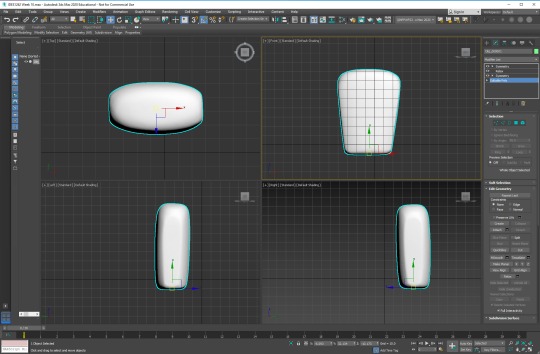
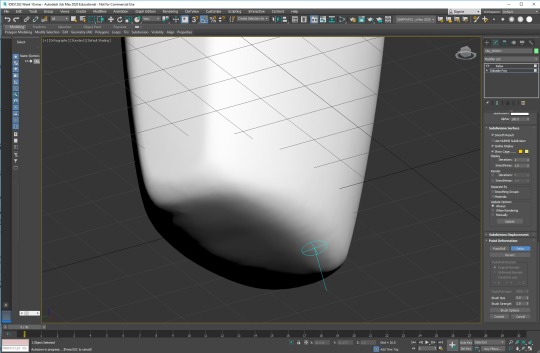
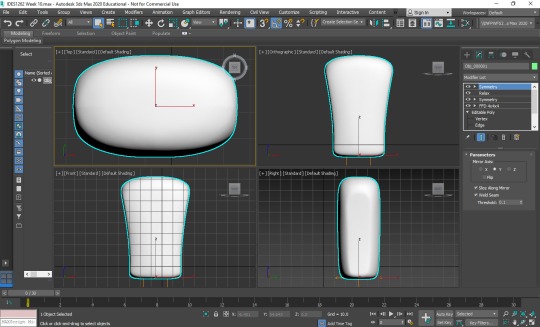
Images 1-3: Olay bottle final adjustments on Autodesk 3ds Max
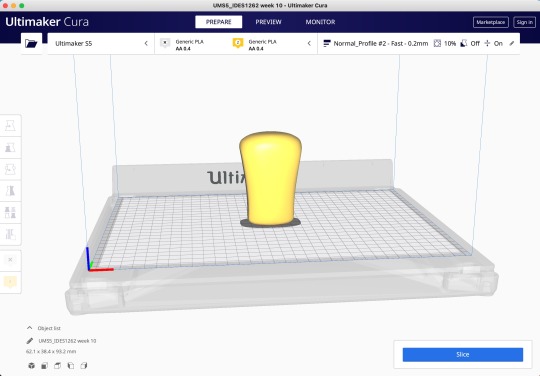
Image 4: File to CURA for 3D printing
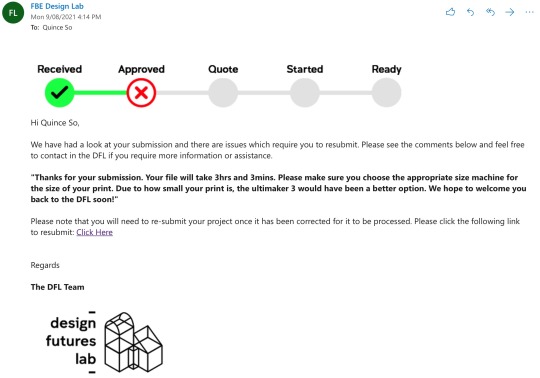
Image 5: Submission confirmation of test file
Final Reflection
The IDES1262 lectures and tutorials provided a breadth of knowledge and learning opportunities in the design techniques, communication, and iterative design process. The practical skills picked up in this course are invaluable, and I see myself regularly practising hand sketching and digital modelling for many years to come.
My three main takeaways from this course including:
1. The importance of hand sketching and drawing
Although computer-aided design techniques and programs are trending, the need for hand sketching will likely continue to play a prominent role in the design process for a long time. It’s easy for designers to pull out a pen and paper to draw out a rough idea when inspiration hits quickly. The use of used good linework, colours, and shading to explore curves and contours of various products is something that I will focus on going forward.
2. Mindset change to embrace imperfections and mistakes
There is a time and place for perfection such as technical and engineering drawings. However, drawing and designing are iterative processes. It is important to spend more time drawing and enabling creative flow and less worrying about creating perfect lines on the page. I found that changing my mindset and moving away from creating perfect measured lines on a page to creating rough drawings with mistakes has helped me focus on the importance of creating draft ideas. Design is an iterative process at the end of the day, and spending too much time on a draft/low fidelity design takes time away from your final design. Plus, mistakes are another learning opportunity.
3. Importance of reflections
Reflective thinking was not something that I spend much time doing before taking this course. However, I have come to embrace this new skill. The process of reflective thinking helped me look deeper into what, why, and how something was being created. It provides a good learning opportunity to review the process I took and find alternative ways to approach future tasks.
Lastly, I want to thank Rob, Gonz and Tom for sharing your knowledge, assisting with the engaging weekly exercises, and providing first-person accounts of your experiences in real-world applications.
Good luck and all the best everyone,
Quince
6 notes
·
View notes
Photo










Week 10 My Final And Our finals
Comprehensively, this post will start from the insight first, because I have lots of thoughts to share. IDES1262 can be concluded in one famous sentence, “Some of the most devastating things that happen to me have taught me the most”. Study with the flow by the course, I have experienced and well understand the sketch and modeling system in some way, from basic modeling techniques, tools, and computer-aided design. Apart from tangible improvements on hands-on skills, within the most essential part, the communication of design has been enhanced - design thinking. There are loads of ways that I can present and express my idea, which generates more radical thinkings and a creative approach towards design thinking.
😫As I mentioned at the beginning, every time starting from new was a thorny issue, and for me, I could be anxious and nervous. I always met difficulties at the preliminary stage, such as how to draw orthographic and engineering drawings, because apparently, they were precise and professional. Hence, my biggest problem among all was hard to start from zero.
Luckily, I would appreciate this course: IDES1262 offers the entrance ticket for me. Although I was still a freshman for modeling, still with tons of doubts when looking at online masterpieces by designers, this entrance ticket provided a series of exercises, including 3d max, cura, technical drawings, and foam modeling, which symbols I have started my journey. Now, the surface or the process of each system was familiar for me, where the anxiety vanished. Indeed, excitement and passion happen. I am looking forward to industrial design more and more, day by day!

From this point of view, pre-activity was always been my favorite. Occasionally, if there is material, I would print them out, and so far, there was a book on my desk for regular review. However, things would not be perfect. I dislike and was tired of the resolution of online classes. It did waste time for me to figure out every step, especially for the latter course in July and August.
Besides, other activities looked fundamental but were fun and communicative. Firstly, the community online, I always browse different output and sent messages to others; we have connections, not only from asking questions and appreciation, but also an influence for each other. There was a desire that I hope to meet everyone offline! Secondly, to document and record works online was a new attempt for me. If I did again, I would definitely prepare the bbcollab at first, there were many difficulties when using it. Indeed, the resolution and the stability of this software still is an issue. Therefore, by comparison, I love Tumblr! Tumblr is great, especially searching the tag in previous years, past works would pop out❤.

At last, thank you again to Rob, Gonz, and Tom: the content was rich and it gives me a precious entrance ticket! Thus, during the vacation, I could explore as many as I want into the further page. Hope to see everyone again next term.
10 notes
·
View notes